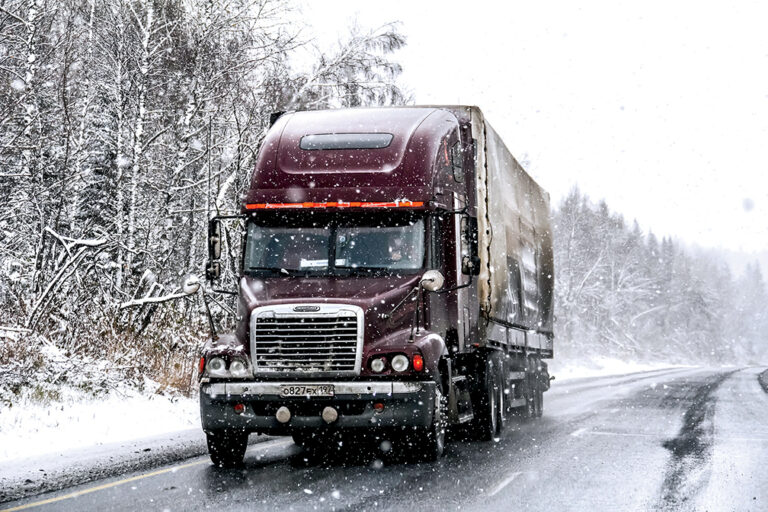Winter will soon arrive. In fact, in parts of North America, the weather might already be winter-like. The further north and the higher in elevation you are, the more likely winter weather will be a part of the mix.
Professional drivers should take the time to prepare their vehicles — and themselves — for what’s to come in the months ahead. Start with a thorough inspection of the truck, including stocking up with extra supplies.
Tires need good traction any time of year, but this is especially important when snow and ice make it tougher to get a grip on the pavement. Even if a tire isn’t at replacement point, it might be wise to put a new tire in its place. Sometimes tires with less tread can be put on trailers for the remaining 32nds of tread depth, while the steering axle gets new rubber.
Likewise, proper tire inflation is always important, but even more so in winter. Tires are designed to have a solid “footprint” at the right PSI (pound per square inch). Over- or under-inflated tires mean less tread is in contact with road surfaces.
Wires are another inspection point. Any place a wire has been spliced or connected to anything is subject to corrosion. Salt and other chemicals used on roadways in icy weather, when churned into the air as road spray, have a way of getting into the tiniest crevices and causing corrosion that can shut down the circuit. Applying fresh electrical tape, liquid tape or a new connector could help ensure a problem-free winter.
Carrying extra fluids can make a difference, too. Oil and coolant should always be carried, since sensors that detect low levels can shut down an engine. That’s not a good proposition when you’re parked (or stuck) and need heat. Extra windshield wash is a must, as winter road spray can quickly dry on windshields and windows, forming a layer of gunk that’s hard to see through. A small spray bottle and a short squeegee come in handy for giving the mirrors a quick cleaning. Heated mirrors dry water droplets, leaving anything mixed in as a residue on mirror surfaces.
Every driver should have at least one spare fuel filter, along with the tools needed to change it. Most fuel retailers blend fuel for winter conditions, and trucks are equipped with return fuel lines that help keep the fuel in the tanks warm enough to prevent gelling. Still, every year you’ll see drivers stuck on the roadside with a truck that stopped running because of paraffin (gel) buildup in the fuel. When the fuel gels up, APUs and bunk heaters don’t work, either. Having a spare fuel filter, a gallon of fuel deicer and the tools — and knowledge — to change filters can literally save your life.
Don’t forget chains. Some states require them during winter months, even if they aren’t needed. Many drivers feel that if the weather is bad enough to require the use of chains, they should park and wait it out. That can be a good strategy; however, chains may be needed to get through a mountain pass or even to get to the next safe parking space. Drivers traveling in areas prone to winter weather should carry chains, and should know how to put them on.
Your truck’s winter supplies should include products for the driver, too. Every winter there are stories of people stranded on highways that are closed due to extreme weather or weather-related accidents. A winter food kit should include high-protein products such as energy bars, jerky or canned tuna. Dehydration can be an unexpected problem in cold weather, because you exhale water vapor from your body with every breath. Carry a supply of bottled water in the truck, just in case.
Getting used to the climate-controlled environment of a truck cab makes it easy for drivers to leave cold-weather clothing at home. In fact, many drivers get by with just sport shoes and a light jacket to walk back and forth between the truck stop and truck. A smarter strategy would be to prepare to be stranded, or at least to be outside for a few hours working around the truck. Pack a good cold-weather coat, along with a hat and gloves. Snow boots are a good idea, too — or at the very least, a pair of rubber boots that can be worn over street shoes. You should also carry a sleeping bag, too; it can provide enough warmth to save a live.
Don’t forget mental preparation: It never hurts to review winter driving techniques, like reducing speed and allowing more following distance. Winter weather is sometimes easy to predict; either there is snow or ice, or there isn’t. Some dangerous conditions, however, aren’t as simple. A light rain or mist can turn into treacherous freezing rain with a drop of just a degree or two in temperature. Changing elevation, such as when going up a mountain, can take a driver through several different sets of driving conditions in a short period of time.
Ice can be particularly dangerous. Ice forms on bridges and overpasses before it does on pavement, which is in contact with and pulls heat from the ground. Black ice has the deceptive appearance of a wet (not frozen) road. When in doubt, assume you’re traveling in the most dangerous road conditions, and act accordingly.
Features on modern trucks make the driving job easier and can even save lives, but some of them can be deadly when used in the wrong conditions. Engine brakes, for example, take much of the anxiety out of descending steep grades. However, they can cause a rig to jackknife on a slippery surface. Engine brakes should be turned off, or at least a lower selection, when conditions are slippery. Cruise control can instruct the truck to accelerate at the worst possible time and should also be turned off when conditions are slippery.
Advanced driver-assist systems (ADAS) such as automatic braking and steering assist can also create problems in bad weather by applying brakes or adjusting steering when it’s the wrong thing to do because of surface conditions. Be aware of these tendencies.
Winter presents a unique set of challenges to drivers and to the vehicles they pilot. Being prepared with extra supplies and warm weather gear, plus preparing mentally, will help you truck on through winter weather and make it safely to spring with a minimum of problems.
Cliff Abbott is an experienced commercial vehicle driver and owner-operator who still holds a CDL in his home state of Alabama. In nearly 40 years in trucking, he’s been an instructor and trainer and has managed safety and recruiting operations for several carriers. Having never lost his love of the road, Cliff has written a book and hundreds of songs and has been writing for The Trucker for more than a decade.








